Mandatory SuDS for England
Sustainable Drainage Systems (SuDS) are set to become mandatory on developments in England next year, heralding the wider use of permeable surfaces throughout our towns and cities.
‘The Flood and Water Management Act 2010’ included provisions for effectively mandatory SuDS on developments, approved by local authority ‘SuDS Approving Bodies’ (SABs). But these provisions were not implemented at the time in England under Schedule 3 of the Act – although they were in Wales – relying instead on planning policies for flood protection.
Under mounting pressure and recognising that the planning-based system has not worked, government is now moving towards implementing Schedule 3 in England to make SuDS mandatory, announced in a review from Defra on 10th January. A public consultation later this year will help to shape the new approach, with implementation expected during 2024.
National SuDS Standards and other related changes will then be applied to England, largely based on experience in Wales. SABs will be set up within unitary authorities or county councils and their approval will be required before construction of drainage systems on new and redeveloped sites (except single buildings or permitted development under 100 square metres) or connection to public sewers. The SAB may adopt and maintain approved SuDS that serve more than one property.
This is an important step forward, not just in the fight against flooding but also in enabling the numerous multifunctional benefits of well-designed SuDS to be realised, particularly in response to climate change. This welcome move towards wider use of permeable surfaces will also help to reverse the “sealing-up” our towns and cities, highlighted in the November 2022 ‘National Infrastructure Commission’ report on reducing surface water flooding.
The Key to SuDS
Having proven itself over decades of successful use around the world, concrete block permeable paving is unique as a SuDS technique in combining proven engineering design solutions with water management replicating nature, near the surface. Replacing the impermeable surfaces that cause the runoff issues that SuDS seek to address, it not only provides a particularly useful source control technique at the head of a ‘SuDS management train’ but also achieves all four well-known pillars of SuDS: Quantity…Quality…Amenity…Biodiversity.
Of course, safe and attractive hard surfaces are needed in any development. But concrete block permeable paving offers the potential for multifunctionality and integration with the SuDS management train as well, without additional land-take.
Its unique capabilities offer designers the potential of a gradual supply of clean, treated water for safe, open SuDS features, landscapes and amenities. It can also meet the latest planning requirements for street trees with long-term maintenance, providing diffuse rainwater infiltration and retention, plus free air movement to roots without surface disruption.

